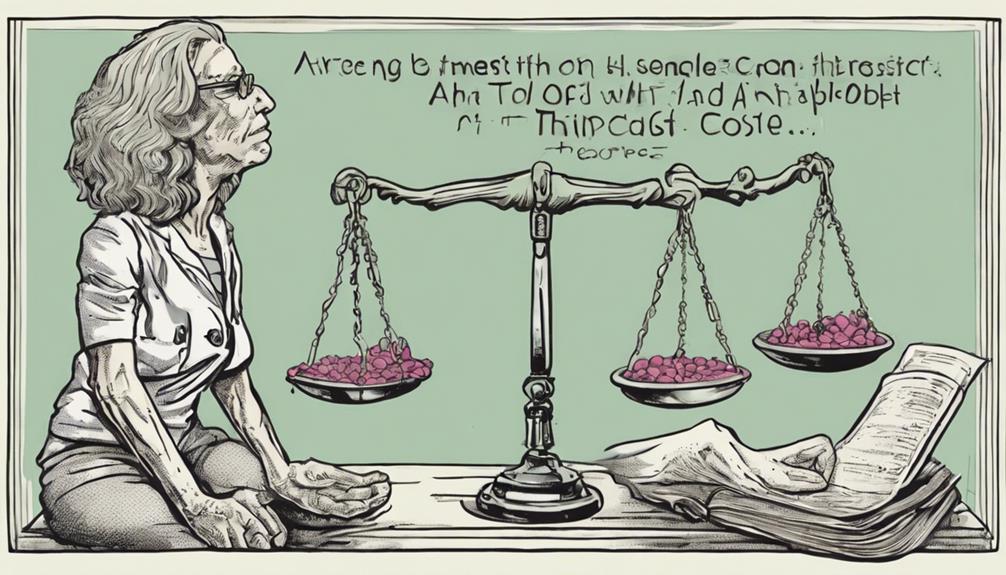Curious about how much somatic therapy sessions cost? Generally, you can expect to pay between $100 and $200 for each session. The cost can be influenced by several factors, including the therapist’s experience, the location of the therapy, and how long each session lasts. Often, therapists in big cities or those with specific expertise might have higher rates. Moreover, options like a sliding fee scale and discounts for booking multiple sessions can make the treatment more accessible. Insurance coverage also plays a role and can differ, especially in terms of reimbursement for providers outside your network. Knowing these aspects can help you get a better idea of the expected expenses. Dive in to learn more about the pricing of somatic therapy!
Key Takeaways
- Somatic therapy session costs range from $100 to $250.
- Sliding scale fees may be available based on income.
- Insurance coverage varies for out-of-network reimbursement.
- Transparent pricing includes session costs and additional fees.
- Therapist experience and location influence pricing.
Somatic Therapy Cost Factors
When considering the cost of somatic therapy sessions, various factors such as location, therapist experience, and session duration play a significant role in determining the overall expense. Somatic therapy, aimed at addressing the mind-body connection, can range in cost due to these factors.
Therapists practicing in metropolitan areas often charge higher fees compared to those in rural areas. Additionally, therapists with extensive experience and specialized training may command higher rates for their services. Session duration also impacts the cost, with longer sessions typically costing more than shorter ones.
Understanding these cost factors is vital when seeking somatic therapy. While average fees in the U.S. range from $100 to $250 per session, it's important to inquire about sliding scale fees based on income that some therapists offer. Moreover, checking insurance coverage for somatic therapy is advisable, as coverage levels vary and some therapists may not accept insurance.
For out-of-network services, reimbursement possibilities exist, but policies differ among insurance companies.
Average Session Fees

The average cost range for somatic therapy sessions typically falls between $100 and $200 per session, influenced by factors such as location, therapist experience, and specialization in somatic therapy. When seeking a somatic experience, it's crucial to take into account these variables that may impact session fees.
Therapists in metropolitan areas or with extensive experience in somatic therapy might charge higher fees compared to those in rural areas or with less experience. Health insurance coverage for somatic therapy sessions varies among providers, with some therapists being out-of-network providers. It's advisable to check with your insurance company about coverage for somatic therapy and inquire whether the therapist accepts your insurance.
Understanding the potential costs and payment options associated with somatic therapy sessions can help you plan your sessions effectively. Remember to discuss fees and payment arrangements with your therapist to ensure a transparent and manageable financial experience during your somatic therapy journey.
Sliding Scale Options

You can benefit from sliding scale options for somatic therapy sessions, as they adjust fees based on your income level. This income-based fee scaling aims to make therapy more affordable and accessible to a wider range of clients.
Understanding the fee adjustment criteria can help you determine if you qualify for reduced rates.
Fee Adjustment Criteria
Considering individual income levels, sliding scale options for somatic therapy sessions adjust fees to guarantee affordability for all clients. Sliding scale fee adjustments are based on factors such as financial need, household size, and the client's ability to pay.
These criteria help ensure that therapy remains accessible to individuals who may not be able to afford standard session rates. By offering sliding scale options, somatic therapists aim to accommodate a range of financial circumstances, making their services more inclusive and equitable.
Clients with limited financial resources can benefit from these fee structures, which provide a more affordable alternative to traditional therapy costs. Ultimately, sliding scale fee adjustments play an essential role in expanding access to somatic therapy and supporting individuals in receiving the care they need, regardless of their financial constraints.
Income-Based Fee Scaling
Sliding scale choices for somatic therapy sessions provide a flexible fee structure based on individual income levels, guaranteeing affordability for clients with varying financial situations. This income-based fee scaling model allows individuals to pay reduced fees for therapy sessions based on their financial circumstances.
By offering sliding scale choices, somatic therapists aim to make their services more accessible to those facing financial constraints. The availability of sliding scale fees varies among therapists and practices, so it's advisable to inquire about this option when considering somatic therapy.
This approach helps secure that individuals in need of somatic therapy can receive the support they require without being burdened by high costs. If you're concerned about the affordability of somatic therapy, exploring sliding scale choices could be a beneficial way to access the care you need within a budget that works for you.
Multiple Session Discounts

You can learn more about how somatic therapy session costs break down, the criteria for eligibility for discounts on multiple sessions, and the payment plan options available to you.
Understanding these points will help you make informed decisions about your somatic therapy journey and budget effectively.
Be sure to take into account these factors when planning your sessions with a somatic therapy practitioner.
Session Cost Breakdown
Therapists often provide discounted rates for clients who schedule multiple somatic therapy sessions, offering a cost-effective option for ongoing treatment. These discounts can notably reduce the overall cost per session, making somatic psychotherapy more accessible to individuals seeking long-term care. Additionally, insurance coverage for somatic therapy may help offset some of the out-of-pocket expenses, further easing the financial burden for clients.
To give you a clearer idea of how multiple session discounts can benefit you, here's a breakdown showcasing potential savings:
| Number of Sessions | Regular Cost per Session | Discounted Cost per Session |
|---|---|---|
| 1 | $200 | – |
| 5 | $200 | $180 |
| 10 | $200 | $160 |
As illustrated in the table, scheduling more sessions often leads to a lower cost per session, allowing you to receive the benefits of somatic therapy at a reduced rate.
Discount Eligibility Criteria
Eligibility for multiple session discounts in somatic therapy is determined based on the client's dedication to a specified number of sessions within a set time frame. To qualify for these discounts, clients typically need to book and pay for a package of sessions upfront.
Here are some key points to take into account regarding discount eligibility criteria for multiple session discounts in somatic therapy:
- Discounts are available for clients who dedicate to a series of sessions.
- Clients can often secure reduced rates by purchasing sessions in advance.
- Eligibility criteria may involve booking a certain number of sessions upfront.
- Committing to a set number of sessions within a specified time frame is common.
- Taking advantage of multiple session discounts can lead to cost savings and a more structured treatment plan.
Payment Plan Options
Clients exploring somatic therapy sessions can benefit from considering payment plan options that offer discounts for multiple sessions. Opting for a payment plan with discounts can make ongoing somatic therapy more financially feasible. Many somatic therapy practices provide clients with the opportunity to save money by committing to a series of sessions upfront. These payment plans aim to support individuals seeking consistent treatment by offering reduced rates for their sessions.
When scheduling somatic therapy appointments, clients are encouraged to inquire about the availability of multiple session discounts. Payment plans with discounts may vary among somatic therapists and their specific practice policies. By understanding and utilizing these payment options, clients can prioritize their healing journey without the added stress of financial burden.
| Therapy Practice | Discount Offer |
|---|---|
| ABC Somatic Therapy | 10% off for 5 sessions |
| XYZ Healing Center | 15% off for 10 sessions |
| Mindful Movement | 20% off for 8 sessions |
| Harmony Wellness | 12% off for 6 sessions |
Insurance Coverage Details

When considering insurance coverage details for somatic therapy sessions, it's important to understand that coverage can vary greatly. Here are some key points to keep in mind:
- Somatic therapy sessions may be partially covered by insurance as an out-of-network provider.
- Insurance coverage details vary, including co-payments for therapy sessions.
- Therapists can provide a bill for reimbursement to clients seeking out-of-network services.
- It's essential to inquire about available benefits, such as coverage amounts per session and sessions per year.
- Primary care physician approval and diagnostic codes may be required for insurance reimbursement.
Understanding these aspects of insurance coverage can help you navigate the financial aspect of somatic therapy sessions more effectively.
Be sure to contact your insurance provider to get specific details about coverage for out-of-network providers and any potential reimbursement processes.
Out-of-Network Reimbursement

For some individuals seeking somatic therapy sessions, utilizing out-of-network reimbursement options can provide partial coverage through their insurance provider. This means that you may need to pay the full session fee upfront and then submit a claim to your insurance company for reimbursement.
The reimbursement rates can vary depending on your insurance plan, covering a percentage of the therapy session cost. To make the most of this option, check with your insurance provider to understand the reimbursement process, required documentation, and any coverage limits that may apply.
Financial Assistance Availability

Financial assistance programs for somatic therapy sessions can provide relief for individuals facing financial constraints. If you're in need of financial support for somatic therapy, consider the following:
- Sliding Scale Fees: Some somatic therapists offer sliding scale fees based on income.
- Reduced Fee Slots: Therapists may have reduced fee slots available for individuals experiencing financial hardship.
- Accessibility: Sliding scale fees help make somatic therapy more accessible and affordable for those in need.
- Varied Availability: The availability of financial assistance varies among somatic therapists, so it's important to inquire about options.
- Direct Contact: Contacting the therapist directly to discuss financial assistance options for somatic therapy sessions is recommended.
Exploring these avenues can help you find the financial assistance you need to access beneficial somatic therapy sessions.
Therapist's Experience Impact

The experience level of a therapist greatly influences the cost of somatic therapy sessions. More seasoned therapists in the field of somatic therapy tend to charge higher fees due to their advanced training and expertise. Those who've been practicing for several years and have established a strong reputation may command premium rates for their services.
Additionally, highly specialized therapists with advanced training in specific modalities within somatic therapy often charge higher fees for their specialized skills. The location of the therapist's practice also plays a role in pricing, with urban areas generally having higher rates compared to rural areas.
Therapists who offer additional services or unique modalities within somatic therapy may also charge more for their expertise. When considering somatic therapy sessions, taking into account the therapist's experience level is crucial as it can impact both the quality of the session and the cost.
Transparency in Pricing

Ensuring clear and upfront information on session costs and any additional fees is fundamental in somatic therapy to promote transparency in pricing. It's pivotal for clients to understand the financial aspects of therapy to make informed decisions about their healthcare.
Here are some key points to keep in mind regarding transparency in pricing:
- Somatic therapy sessions typically range from $100 to $250 per session, depending on various factors.
- Some therapists offer sliding scale fees based on income to help make therapy more accessible.
- Insurance coverage for somatic therapy can vary, with reimbursement options available for out-of-network providers.
- Therapists should provide clear information on session costs and any additional fees upfront to avoid confusion.
- Online therapy options for somatic therapy may have different pricing structures, some offering lower fees compared to traditional in-person sessions.
Frequently Asked Questions
How Much Is Somatic Healing?
Somatic healing costs vary, typically ranging from $100 to $300 per session. Some therapists offer sliding scale fees based on income. Insurance coverage varies, with some accepting out-of-network benefits. On average, sessions cost $150 to $200.
Is Somatic Therapy Worth It?
When considering somatic therapy, trust the process. The benefits, like improved mental health and stress reduction, often make the cost worth it. Your well-being is invaluable, and investing in yourself is a priority.
How Long Does Somatic Therapy Take?
Somatic therapy sessions typically last 50-90 minutes, varying based on the therapist's approach and your needs. On average, sessions run around 60 minutes but longer ones may be needed for specialized work.
How Many Sessions Are Needed for Somatic Experiencing?
To benefit from Somatic Experiencing, your therapy journey's length varies. Factors like trauma complexity and individual response impact session needs. Typically, expect 10-20 sessions. Your therapist assesses to tailor your healing path.
Conclusion
Now that you know the factors that can influence the cost of a somatic therapy session, you can make an informed decision that suits your budget and needs.
Remember, the price tag shouldn't be the be-all and end-all – finding the right therapist for you is worth its weight in gold.
So go ahead, explore your options and invest in your well-being without breaking the bank.
Your journey to healing is within reach!










